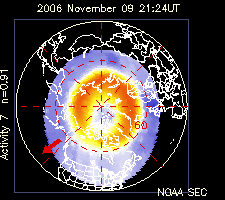The aurora oval
The auroral zones represent the places on earth where auroras occur most often and with greatest intensity. It was the Swiss physicist Herman Fritz (1829-1902), in the 1881 book "Das Polarlicht." who first showed that the northern lights have a maximum zone close to 67 degrees north. He called this belt the auroral zone. Thus, the auroral zones encompass the statistical distributions in latitude of all visible, night side auroras. The more detailed location of the auroral zones is based on professor Størmer's extensive auroral observations between 1910 and 1950.

The momentary, instantenous distribution of the auroras as a function of both latitude and local time were mapped by ground, rocket and satellite measurements in the 1960s. The best overview was obtained by satellite photos of the earth. Then it was discovered that the auroras display a continous oval zone around the magnetic pole in both hemispheres. Thus the auroral ovals are the regions on earth where the auroras are seen most often and with the greatest intensity.
The auroral oval is nearly twice as wide and twice as far from the magnetic pole at midnight as at midday, about 23 degrees and 12 degrees, respectively. On the night side the oval is roughly 10 degrees (about 1100 kilometres) closer to the equator than at the day side.
 The auroral oval can be regarded as fixed in space with reference to the sun. As the earth revolves underneath, the daily variations in the aurora's position occur. In the Scandinavian sector you find that Andøya Rocket Range is located under the oval at night, while the oval lies across Svalbard during daytime. Halfway between northern Norway and Svalbard, northern lights can be observed in zenith both morning (around 0600) and evening (around 1800).
The auroral oval can be regarded as fixed in space with reference to the sun. As the earth revolves underneath, the daily variations in the aurora's position occur. In the Scandinavian sector you find that Andøya Rocket Range is located under the oval at night, while the oval lies across Svalbard during daytime. Halfway between northern Norway and Svalbard, northern lights can be observed in zenith both morning (around 0600) and evening (around 1800).
Modern studies have clearly shown that the shapes and locations of the ovals vary greatly with solar activity. With increasing activity on the sun, the oval widens and spreads, mainly towards the equator.



